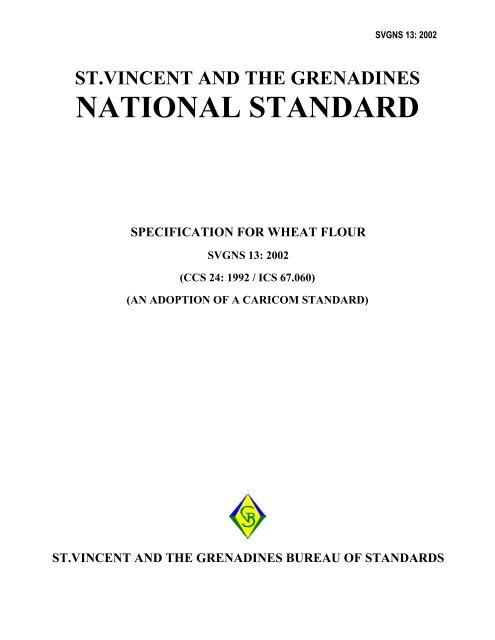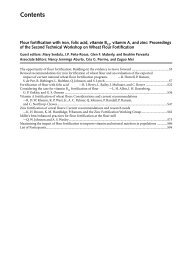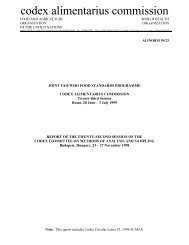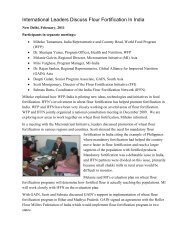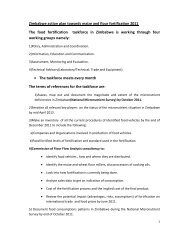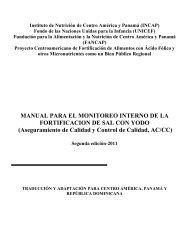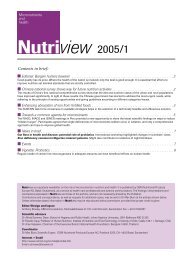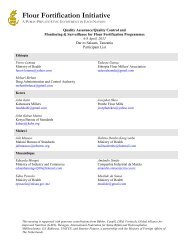St. Vincent and Grenadines
St. Vincent and Grenadines
St. Vincent and Grenadines
Create successful ePaper yourself
Turn your PDF publications into a flip-book with our unique Google optimized e-Paper software.
SVGNS 13: 2002<br />
ST.VINCENT AND THE GRENADINES<br />
NATIONAL STANDARD<br />
SPECIFICATION FOR WHEAT FLOUR<br />
SVGNS 13: 2002<br />
(CCS 24: 1992 / ICS 67.060)<br />
(AN ADOPTION OF A CARICOM STANDARD)<br />
ST.VINCENT AND THE GRENADINES BUREAU OF STANDARDS
SVGNS 13: 2002<br />
ST. VINCENT AND THE GRENADINES NATIONAL STANDARD<br />
SPECIFICATION FOR WHEAT FLOUR<br />
SVGNS 2: 2001<br />
(CCS 24: 1992 / ICS 67.060)<br />
(AN ADOPTION OF A CARICOM STANDARD)<br />
Copyright (c)<br />
<strong>St</strong> <strong>Vincent</strong> <strong>and</strong> the <strong>Grenadines</strong> Bureau of <strong>St</strong><strong>and</strong>ards<br />
No part of this publication may be reproduced in any form without<br />
the prior permission of the <strong>St</strong> <strong>Vincent</strong> <strong>and</strong> the <strong>Grenadines</strong> Bureau of <strong>St</strong><strong>and</strong>ards<br />
in writing. This does not preclude quotation for the purposes of review or comments.<br />
ST VINCENT AND THE GRENADINES BUREAU OF STANDARDS<br />
P.O. Box 1506<br />
Kingstown, <strong>St</strong>.<strong>Vincent</strong>. W.I<br />
Tel: (784) 457 8092 Fax: (784) 457-8175 Email: svgbs@caribsurf.com<br />
GRADE: II<br />
1
SVGNS 13: 2002<br />
GENERAL STATEMENT<br />
The <strong>St</strong>. <strong>Vincent</strong> <strong>and</strong> the <strong>Grenadines</strong> Bureau of <strong>St</strong><strong>and</strong>ards (SVGBS) was established under the<br />
<strong>St</strong><strong>and</strong>ards Act No. 70 of 1992 (amended by Act No. 28 of 20010 as a corporate body, but is<br />
presently under the aegis of Ministry of Industry, Telecommunications, Science <strong>and</strong> Technology.<br />
The SVGBS has statutory responsibilities for the quality of goods <strong>and</strong> services subject to trade in<br />
<strong>St</strong>. <strong>Vincent</strong> <strong>and</strong> the <strong>Grenadines</strong> (SVG), <strong>and</strong> is the only National Body charged with the<br />
responsibility of declaring National <strong>St</strong><strong>and</strong>ards<br />
A National <strong>St</strong><strong>and</strong>ards Council (NSC) appointed by Cabinet administrates the General Affairs of<br />
the Bureau. The members on this Council are selected from the public <strong>and</strong> private sector with<br />
interest, qualifications <strong>and</strong> experience in fields relating to st<strong>and</strong>ards. The NSC is the main policy<br />
organ <strong>and</strong> the regulator of the SVGBS. Its principal responsibility is to determine <strong>and</strong> approve<br />
policy guidelines to ensure that the st<strong>and</strong>ardisation activities pursued by the Bureau play a vital<br />
part in the development of the national economy.<br />
The primary functions of the Bureau are to promote <strong>and</strong> encourage the maintenance of st<strong>and</strong>ards,<br />
to improve the quality <strong>and</strong> performance of goods, processes, practices <strong>and</strong><br />
services produced <strong>and</strong> or used in the state of <strong>St</strong>.<strong>Vincent</strong> <strong>and</strong> the <strong>Grenadines</strong>, to ensure industrial<br />
efficiency, to assist in industrial development <strong>and</strong> to promote public <strong>and</strong> industrial welfare,<br />
health <strong>and</strong> safety, <strong>and</strong> also to safeguard against negative effects to the environment.<br />
NOTE:<br />
In order to keep abreast of progress in the industries concerned, <strong>St</strong>.<strong>Vincent</strong><br />
<strong>and</strong> the <strong>Grenadines</strong> National <strong>St</strong><strong>and</strong>ards are subject to periodic review.<br />
Suggestions for improvements are welcomed.<br />
2
SVGNS 13: 2002<br />
TABLE OF CONTENTS<br />
Item No. Item Page No<br />
0.0 NATATIONAL FORWARD 4<br />
0.2 FOREWORD 5<br />
1.0 SCOPE 6<br />
2.0 DEFINITIONS 6<br />
3.0 GENERAL REQUIREMENTS 7<br />
4.0 SPECIFIC REQUIREMENTS 7<br />
5.0 FOOD ADDITIVES WHICH MAY BE USES 9<br />
6.0 CONTAMINANTS - LIMITS 9<br />
7.0 HYGIENE 10<br />
8.0 PACKAGING REQUIREMENTS 10<br />
9.0 LABELLING REQUIREMENTS 10<br />
10.0 QUALITY INSURANCE 12<br />
11.0 METHODS OF SAMPLING 12<br />
12.0 METHODS OF TEST 15<br />
13.0 CONFORMITY 15<br />
APPENDIX A Determination of Moisture 17<br />
APPENDIX B Determination of Ash Content 18<br />
APPENDIX C Determination of Protein 19<br />
3
SVGNS 13: 2002<br />
SPECIFICATION FOR WHEAT FLOUR<br />
SVGNS 13: 2002<br />
________________________________________________________________________<br />
0.0 NATIONAL FOREWORD<br />
0.1.1 This CARICOM <strong>St</strong><strong>and</strong>ard was adopted <strong>and</strong> declared for use as an approved <strong>St</strong>.<strong>Vincent</strong><br />
<strong>and</strong> the <strong>Grenadines</strong> National <strong>St</strong><strong>and</strong>ard by the National <strong>St</strong><strong>and</strong>ards Council on the<br />
29 th May 2002.<br />
0.1.2 This st<strong>and</strong>ard is identical to the Caribbean Community <strong>St</strong><strong>and</strong>ard – Specification for<br />
Wheat Four, from which it was adopted.<br />
0.1.3 The <strong>St</strong>.<strong>Vincent</strong> <strong>and</strong> the <strong>Grenadines</strong> Bureau of <strong>St</strong><strong>and</strong>ards has recommended that this<br />
st<strong>and</strong>ard be declared a compulsory st<strong>and</strong>ard so as to prevent fraud or deception arising<br />
from misleading advertising or labelling <strong>and</strong> to provide adequate information to the<br />
purchaser or consumer.<br />
0.1.4 This st<strong>and</strong>ard will be effective as a compulsory st<strong>and</strong>ard on a date to be notified by the<br />
Minister responsible for the <strong>St</strong>.<strong>Vincent</strong> <strong>and</strong> the <strong>Grenadines</strong> Bureau of <strong>St</strong><strong>and</strong>ards in a<br />
Notice to be published in the <strong>St</strong>.<strong>Vincent</strong> <strong>and</strong> the <strong>Grenadines</strong> Gazette as required by the<br />
<strong>St</strong><strong>and</strong>ards Act No 70 of 1992.<br />
4
SVGNS 13: 2002<br />
0.2 FOREWORD<br />
0.2.1 This st<strong>and</strong>ard has been prepared through the Caribbean Common Market <strong>St</strong><strong>and</strong>ards<br />
Council (CCMSC)* to set a level of quality for wheat flour manufactured <strong>and</strong> traded<br />
within the Caribbean Community. It was accepted by the CCMSC in June 1992, after<br />
the consideration of comments received on a draft circulated between November 1990<br />
<strong>and</strong> June 1992, <strong>and</strong> approved by Council of Ministers in June 1992 for use as a<br />
m<strong>and</strong>atory st<strong>and</strong>ard.<br />
0.2.2 Wheat flour that conforms to this st<strong>and</strong>ard <strong>and</strong> which is made under an approved system<br />
of quality assurance may be identified by the Caricom <strong>St</strong><strong>and</strong>ard Mark, which is<br />
administered by CCMSC. This programme is supported by the Caricom Export<br />
Development Project.<br />
0.2.3 This st<strong>and</strong>ard sets out the requirements for wheat flour, <strong>and</strong> describes the methods of<br />
sampling <strong>and</strong> testing that should be used. Wheat flour is now manufactured in several<br />
competing with imports from other countries. As wheat flour is an important nutritional<br />
input in domestic cookery, <strong>and</strong> in industrial or commercial baking, an agreed <strong>and</strong><br />
acceptable level of identity, purity, quality, acceptability, <strong>and</strong> nutrient value is desirable<br />
so that flour from the regional sources can move freely within the Community.<br />
0.2.4 In preparing this st<strong>and</strong>ard, guidance was derived from the following:<br />
(a) Codex <strong>St</strong><strong>and</strong>ard for Wheat Flour (Worldwide <strong>St</strong><strong>and</strong>ard), CODEX STAN 152-<br />
1985, FAO/WHO Codex Alimentarius Commission, Rome, Italy;<br />
(b)<br />
<strong>St</strong><strong>and</strong>ard for Flours, Wheaten, CGSB 32-GP-5M, (1978), Canadian General<br />
<strong>St</strong><strong>and</strong>ards Boards, Ottawa, Canada;<br />
(c) Food <strong>and</strong> Drugs Regulations, Canada, B 13.001-002, dated 9 March 1989;<br />
(d) Food <strong>and</strong> Drugs Regulations, Trinidad <strong>and</strong> Tobago, Division 12, 1980.<br />
0.2.5 This st<strong>and</strong>ard will be reviewed, <strong>and</strong> may be revised from time to time to allow for<br />
changes in manufacturing technology or consumer preferences in the Caribbean<br />
Community.<br />
0.2.5 In view of recent decisions in the FAO/WHO Codex Alimentarius/World Food <strong>St</strong><strong>and</strong>ards<br />
Programme, the use of potassium bromate as a food additive in wheat flour is not<br />
permitted by this st<strong>and</strong>ard.<br />
Note*: The CCMSC has been replaced by the CARICOM Regional Organization for<br />
<strong>St</strong><strong>and</strong>ards <strong>and</strong> Quality (CROSQ) as of June 2002.<br />
5
SVGNS 13: 2002<br />
1.0 SCOPE<br />
1.1 This st<strong>and</strong>ard applies to wheat flour (also called flour, white flour, or enriched flour) that<br />
is intended for human consumption, made from clean, sound <strong>and</strong> marketable grades of<br />
millable wheat grains of the spices Triticum aestivum L. (common wheat) or from<br />
Triticum compactum Host, (club wheat).<br />
1.2 It does not apply to:<br />
(a)<br />
(b)<br />
(c)<br />
(d)<br />
(e)<br />
(f)<br />
any product made from durum wheat (hard wheat, T. durum Desf.);<br />
whole wheat flour, whole meal flour or semolina made from common wheat or<br />
club wheat, or mixtures thereof;<br />
wheat flour to be used in brewing, for the production of starch or glutten, or for<br />
non-food use;<br />
wheat flour in which the protein content has been reduced;<br />
wheat flour subjected to special treatments other than bleaching or drying; or<br />
wheat flour containing ingredients not mentioned in Section 4.2 (such as selfraising<br />
flour).<br />
2.0 DEFINITIONS<br />
For the purpose of this st<strong>and</strong>ard the following definitions apply:<br />
2.1 Wheat flour is the product prepared from grains of common wheat (Triticum aestivum<br />
L.) or club wheat (T.compactum Host,) or mixtures of these two species by grinding or<br />
milling processes in which the bran <strong>and</strong> germ are partly removed <strong>and</strong> the rest of the grain<br />
is comminuted to a suitable degree of fineness <strong>and</strong> which may contain any of the<br />
ingredients <strong>and</strong> food additives listed in Sections 4.2, 4.3, <strong>and</strong> 5.0.<br />
2.2 Enriched wheat flour is wheat flour containing vitamins, <strong>and</strong> iron, in the proportions<br />
specified in Table 2. In Members <strong>St</strong>ates where there is a significant nutritional<br />
deficiency of calcium, calcium may be added within the limits specified in Table 2.<br />
2.3 Food Additive means any substance, the use of which results in it or its by-products<br />
becoming a part of, or affecting the characteristics of the flour.<br />
2.4 Type means a description of the end use for which it is recommended, such as "bread"<br />
"cake", "pastry", "cookie", "biscuit", "general purpose", or "all purpose".<br />
6
SVGNS 13: 2002<br />
3.0 GENERAL REQUIREMENTS<br />
3.1 The wheat from which the flour is milled shall be of sound <strong>and</strong> marketable quality <strong>and</strong>, as<br />
far as is possible in good manufacturing practice, free from any objectionable matter.<br />
3.2 Any added ingredients shall be clean, safe <strong>and</strong> of grades of identity <strong>and</strong> quality that are<br />
recognised as suitable for use in foods.<br />
3.3 Food additives shall conform to recognised specifications of identity, purity, <strong>and</strong> safety,<br />
such as those issued by the FAO/WHO Joint expert Committee on Food Additives.<br />
3.4 All processing in the mill, including drying, <strong>and</strong> milling of the wheat, h<strong>and</strong>ling of the<br />
intermediate products, <strong>and</strong> other treatments of the wheat flour, shall be done so that there<br />
are minimal adverse effects on the nutritive value <strong>and</strong> useful technological characteristics<br />
of the flour.<br />
3.5 As far as is possible in good manufacturing practice, wheat flour shall be free from any<br />
objectionable matter, micro-organisms <strong>and</strong> substances originating from micro-organisms,<br />
in amounts that may reasonably be considered to represent a hazard to health.<br />
3.6 The particle size of wheat flour should be such that not less than 98% by mass of the<br />
flour will pass a 212 milli-micron (No 70) sieve.<br />
4.0 SPECIFIC REQUIREMENTS<br />
4.1 Wheat flour shall conform to the requirements of column 2 of Table 1 when tested for the<br />
characteristics in column 1 by the methods indicated in column 3.<br />
TABLE 1<br />
(Section 4.1)<br />
____________________________________________________________<br />
Column (1) Column (2) Column (3)<br />
Characteristic Requirement Method of test<br />
Moisture Not more than 15% Appendix A<br />
Ash, before adding Not more than 1.2% Appendix B<br />
Inorganic matter<br />
Protein (N x 5.7) Not less than 7.0% Appendix C<br />
on a dry basis<br />
7
SVGNS 13: 2002<br />
4.2 Requirements for Nutrients <strong>and</strong> Minerals<br />
The vitamins <strong>and</strong> minerals mentioned in Column 1 of Table 2 shall be present in wheat<br />
flour within the limits specified in Column 2.<br />
TABLE 2<br />
(Section 4.2)<br />
_____________________________________________________<br />
Column (1) Column (2)<br />
Substance<br />
Thiamine<br />
Requirements_______<br />
Not less than 0.44mg <strong>and</strong><br />
not more than 0.77mg/100g;<br />
Riboflavin<br />
Niacin, Niacinamide<br />
Iron<br />
Calcium (optional)<br />
Not less than 0.27mg <strong>and</strong><br />
not more than 0.48mg/100g;<br />
Not less than 3.5mg <strong>and</strong><br />
not more than 6.5mg/100g;<br />
Not less than 2.9mg/100g<br />
not more than 4.6mg/100g;<br />
Not less than 110mg <strong>and</strong><br />
not more than 140mg/10g.<br />
4.3 Wheat flour may contain the following ingredients in amounts necessary for<br />
technological purposes;<br />
(a)<br />
(b)<br />
(c)<br />
(d)<br />
(e)<br />
malted wheat flour;<br />
malted barley flour;<br />
malted rye flour;<br />
wheat gluten;<br />
the following enzymes;<br />
(i) amylase;<br />
(ii) bromelain;<br />
(iii) glucoamylase;<br />
(iv) lactase;<br />
(v) lipoxidase<br />
(vi) protease.<br />
8
SVGNS 13: 2002<br />
(f)<br />
(g)<br />
(h)<br />
(i)<br />
L-cysteine, as hydrochloride, not more than 90 ppm;<br />
calcium carbonate, calcium sulphate, edible bone meal, ground limestone, ground<br />
chalk, in amounts needed to conform to the requirements of Table 2 for calcium<br />
(if added);<br />
ascorbic acid, not more than 200 ppm;<br />
monocalcium phosphate, not more than 2500 ppm.<br />
5.0 FOOD ADDITIVES WHICH MAY BE USED<br />
5.1 The following food additives may be used in wheat flour, within the limits specified, or,<br />
where no limits are stated, in accordance with good manufacturing practices:<br />
(a)<br />
(b)<br />
(c)<br />
(d)<br />
acetone peroxide;<br />
ammonium chloride, not more than 2000 ppm;<br />
ammonium persulphate, not more than 250 ppm;<br />
benzoyl peroxide, not more than 150 ppm combined with not more than 900 ppm<br />
of one or more of the following as carriers:-<br />
- calcium carbonate, calcium sulphate,<br />
- dicalcium or tricalcium phosphate,<br />
- magnesium carbonate, starch,<br />
- potassium or sodium aluminum sulphate;<br />
(e)<br />
(f)<br />
(g)<br />
(h)<br />
(i)<br />
chlorine;<br />
chlorine dioxide;<br />
lecithin, not more than 2000 ppm;<br />
sulphur dioxide (in flours intended for use in making biscuits or pastry), not more<br />
than 200 ppm.<br />
azodicarbonamide, not more than 45 ppm.<br />
6.0 CONTAMINANTS<br />
6.1 Wheat flour shall not contain elements mentioned in column 1 below in amounts<br />
exceeding the limits specified in column 2:<br />
Column (1) Column (2)<br />
Arsenic (As)<br />
1 ppm;<br />
Copper (Cu)<br />
20 ppm;<br />
Lead (Pb) 2 ppm;<br />
Zinc (Zn) 50 ppm.<br />
9
SVGNS 13: 2002<br />
6.2 Where wheat grain used in the production of wheat flour is fumigated to destroy or<br />
control infestations by insects, mites, moulds, or rodents, the residues of pesticides in the<br />
flour shall not exceed those set by the Codex Committee on Pesticide Residues.<br />
7.0 HYGIENE<br />
7.1 Flour shall be manufactured, packaged, transported <strong>and</strong> stored in accordance with codes<br />
of hygienic practice that are approved by the competent authority.<br />
7.2 Particular attention shall be given to the prevention of contamination of the wheat <strong>and</strong><br />
other ingredients, materials in process, equipment, or packaging materials by dirt,<br />
moulds, birds, insects, mites, <strong>and</strong> other vermin.<br />
7.3 Proper housekeeping <strong>and</strong> sanitation practices shall be followed in the storage, milling,<br />
packaging, <strong>and</strong> warehousing sections of the plant.<br />
7.4 The employees shall be trained to follow proper sanitation practices <strong>and</strong> to maintain their<br />
personal cleanliness, <strong>and</strong> shall be provided with the appropriate clothing, toilet, first aid,<br />
changing <strong>and</strong> other facilities that are necessary.<br />
8.0 PACKAGING REQUIREMENTS<br />
8.1 Wheat flour shall be packaged in containers which will safeguard the hygienic,<br />
nutritional, <strong>and</strong> technological characteristics of the flour, <strong>and</strong> protect it against<br />
contamination or absorption of moisture.<br />
8.2 Containers shall be made of materials which are safe <strong>and</strong> suitable for the purpose, such as<br />
bags or sacks of new cotton, multi-wall paper, strong paper, polypropylene fibre, or<br />
plastic film.<br />
8.3 Containers shall not contaminate the product by migration of any toxic substance, or give<br />
the flour any undesirable odour or flavour.<br />
9.0 LABELLING REQUIREMENTS<br />
9.1 The labelling on retail packages of flour shall be in the English language, clearly <strong>and</strong><br />
prominently displayed, <strong>and</strong> readily legible under customary conditions of purchase <strong>and</strong><br />
use. Information presented in other languages shall be clearly separated from that in<br />
English.<br />
10
SVGNS 13: 2002<br />
The information carried on the label shall include:<br />
(a)<br />
(b)<br />
(c)<br />
(d)<br />
(e)<br />
(f)<br />
(g)<br />
(h)<br />
the name of the food, "flour", "wheat flour" or "white flour";<br />
any br<strong>and</strong> name or trade name;<br />
the name of the manufacturer or of the person controlling the br<strong>and</strong> name or trade<br />
name, together with an adequate postal address;<br />
the name of the country of origin;<br />
the average net contents of each package when packed in terms of units of mass in<br />
grams (g) or kilograms (kg), (which may also be shown in avoirdupois pounds<br />
<strong>and</strong> ounces) using Arabic numerals;<br />
where the vitamins <strong>and</strong> minerals mentioned in Table 2 are present in the flour, the<br />
amount of each present in 100g of flour (at 15% moisture content) shall be<br />
declared, expressed in milligrams (mg), <strong>and</strong> the flour may be described as<br />
"enriched", or "vitamin enriched", <strong>and</strong> as "calcium enriched" if the level calcium<br />
is in accordance with Table 2 <strong>and</strong> represents 16.6 per cent of the Recommended<br />
Daily Allowance, (RDA) set by the Caribbean Food <strong>and</strong> Nutrition Institute<br />
(CFNI).<br />
a list of ingredients in descending order of their proportion by weight; the food<br />
additives mentioned in Section 5.0 may be described as bleaching agents, or as<br />
flour improvers.<br />
The batch number, date of manufacture or date of packaging, declared in code or<br />
uncoded, together with a date of minimum durability (expressed as "Best before<br />
end 2003-12" or "Use before end 2003-12")<br />
NOTE:<br />
NOTE:<br />
The date marking should be written in sequence (ISO convention)<br />
year, month <strong>and</strong> day, eg: 2002-05-09, (meaning, 9 th of May 2002).<br />
Labelling requirements shall confirm to the <strong>St</strong>.<strong>Vincent</strong> <strong>and</strong> the<br />
<strong>Grenadines</strong> National <strong>St</strong><strong>and</strong>ard on the Labelling of Prepackaged<br />
Foods.<br />
(i)<br />
<strong>St</strong>orage instructions, in close proximity to the date marking.<br />
9.3 Where an indication of the type of flour is included on the label, the protein <strong>and</strong> ash<br />
contents of the flour shall be within the limits set out in Table 3.<br />
11
SVGNS 13: 2002<br />
TABLE 3<br />
Type of Flour Protein Content Ash Content<br />
All purpose, ) 10.5 to 12.0 % up to 0.5 %<br />
General Purpose )<br />
Biscuit 8.0 to 9.0 % up to 0.45 %<br />
Bread 12.0 to 13.5 % up to 0.6 %<br />
Cake, Pastry 7.0 to 10.0 % up to 0.45 %<br />
9.4 Instructions for use may also be included on the label.<br />
10.0 QUALITY ASSURANCE<br />
10.1 To be eligible for a licence to use the Caricom <strong>St</strong><strong>and</strong>ard mark <strong>and</strong>/or The <strong>St</strong>.<strong>Vincent</strong> <strong>and</strong><br />
the <strong>Grenadines</strong> Bureau of <strong>St</strong><strong>and</strong>ards <strong>St</strong><strong>and</strong>ard Mark the manufacturer of wheat flour shall<br />
operate a quality assurance system conformity to the general requirements of ISO 9002–<br />
1987, using adequate staff, sampling procedures <strong>and</strong> testing equipment, as approved by<br />
the National <strong>St</strong><strong>and</strong>ards Body.<br />
10.2 An approved quality assurance system may include sampling or test procedures suited to<br />
routine or continuous production that differ from those mentioned in Sections 11 <strong>and</strong> 12.<br />
10.3 It is recommended that wheat flour be produced under an approved quality assurance<br />
system.<br />
11.0 METHODS OF SAMPLING<br />
11.1 The methods of sampling which should be used will depend on whether the wheat flour<br />
is:<br />
(a)<br />
(b)<br />
(c)<br />
in a consignment of retail packages (up to 25 kg) in a shipment or in a warehouse;<br />
in bulk packages (over 25 kg, in a freight container or road or rail tanker);<br />
discharged in a stream from a bulk container, or in production in the mill in a<br />
stream moving towards the final packaging operation.<br />
The following methods are recommended; they are based on methods published by ISO<br />
<strong>and</strong> AOAC.<br />
12
SVGNS 13: 2002<br />
11.2 Sampling From a Consignment in Retail Packages<br />
11.2.1 Where a consignment is known to consist of wheat flour packaged from different<br />
manufacturing batches which can be separated, each batch shall constitute one lot.<br />
11.2.2 Where it appears that the lot or consignment includes packages that have been damaged<br />
or contaminated during transport, h<strong>and</strong>ling, or storage, these shall be kept separate <strong>and</strong><br />
sampled separately. Samples of such unsound material shall not be mixed with samples<br />
from the sound material.<br />
11.2.3 Samples shall be taken from packages with clean, polished, pointed metallic triers, <strong>and</strong><br />
placed in sample containers that are clean, dry <strong>and</strong> free from odours which have stood<br />
open for some minutes near the place where the flour is to be sampled. Containers shall<br />
be capable of being sealed air-tight <strong>and</strong> moisture-tight, <strong>and</strong> may be made of glass, metal,<br />
or plastic having no action on the flour.<br />
11.2.4 The number of packages to be sampled will depend on the size of the lot, according to<br />
Table 4.<br />
11.2.5 Samples shall be taken as follows:<br />
(a)<br />
(b)<br />
(c)<br />
from the top, middle, <strong>and</strong> bottom thirds of each package <strong>and</strong> then combined, or<br />
from one top corner to the center of the package diagonally, <strong>and</strong> from the other<br />
top corner diagonally to half the distance to the center of the package, <strong>and</strong><br />
combined;<br />
the combined cores form a "bag sample;"<br />
(d) a bag sample shall be at least 100g;<br />
(e)<br />
(f)<br />
each package shall be re-sealed after sampling;<br />
bag samples shall be properly labelled showing the date <strong>and</strong> place of sampling,<br />
the shipment, <strong>and</strong> the name of sampler, <strong>and</strong> shall be delivered to a laboratory as<br />
soon as possible.<br />
13
SVGNS 13: 2002<br />
TABLE 4<br />
(Section 11.2.4)<br />
Number of Packages to be sampled in a Lot<br />
Number of packages<br />
in Lot<br />
(N)<br />
Number to be sampled<br />
(n)<br />
1 to 10 all<br />
10 to 100 10, taken at r<strong>and</strong>om<br />
101 <strong>and</strong> over the whole number*<br />
the nearest to the square<br />
root of N, taken at<br />
r<strong>and</strong>om or using a<br />
sampling plan.<br />
*For example, if N= 150, n = 12; if N = 200, n = 15;<br />
if N= 300, n = 18; if N = 400, n = 20.<br />
11.2.6 A bulk sample shall be prepared in the laboratory by combining all the bag samples <strong>and</strong><br />
thoroughly mixing them.<br />
11.2.7 The bulk sample may be reduced in size by quartering to give laboratory samples that are<br />
large enough to perform in duplicate the testes specified in Table 1, <strong>and</strong> any other tests<br />
requested; laboratory samples shall be stored in clean dry air-tight <strong>and</strong> moisture-tight<br />
containers that are properly labelled with all relevant information.<br />
11.2.8 In cases of dispute, the bulk sample may be divided into three laboratory samples, one for<br />
each party, <strong>and</strong> one to be kept for reference.<br />
11.3 Sampling from bulk containers, freight containers, <strong>and</strong> tank trucks.<br />
11.3.1 This should be done unloading or unloading the flour using the procedures recommended<br />
in ISO 2170-1980, "Cereals <strong>and</strong> Pulses – Sampling of Milled Products"<br />
11.4 Sampling during production<br />
11.4.1 Samples may be taken from flour moving through the plant before packaging, using h<strong>and</strong><br />
scoops or automatic sampling methods such as those recommended in ISO 2170-1980 or<br />
ISO 6644-1981, "Cereals <strong>and</strong> Milled Cereals Products – Automatic Sampling by<br />
Mechanical Means.<br />
14
SVGNS 13: 2002<br />
12.0 METHODS OF TEST<br />
12.1 The test methods described in Appendices A, B, C <strong>and</strong> D shall be used to determine<br />
whether a sample from a consignment of wheat flour conforms to the requirements of<br />
Table 1.<br />
12.2 The methods in the Appendices should also be used in the routine quality assurance, but<br />
other methods which are more rapid <strong>and</strong> of equal or comparable accuracy may be used.<br />
12.3 Methods for the determination of the levels of thiamine, riboflavin, niacin, niacinamide,<br />
iron, calcium, or for traces of arsenic, copper, lead, <strong>and</strong> zinc are not included in this<br />
st<strong>and</strong>ard. If it is necessary to verify by analysis the proportions of these substances in<br />
wheat flour, analytical methods published by the following organisations should be used:<br />
(a)<br />
(b)<br />
(c)<br />
(d)<br />
Association of Official Analytical Chemists (AOAC), Washington, DC USA;<br />
International Association of Cereal Science <strong>and</strong> Technology (ICC), Schwechat,<br />
Austria;<br />
International Union of Pure <strong>and</strong> Applied Chemistry (IUPAC), Oxford, UK;<br />
American Association of Cereal Chemists (AACC).<br />
12.4 In the absence of any method published by any of these organisations, another method of<br />
test or analysis may be used provided that its accuracy, reproducibility, <strong>and</strong> reliability<br />
have been demonstrated by collaborative tests conducted by laboratories having extensive<br />
experience in the subject.<br />
13.0 CONFORMITY<br />
13.1 A lot or consignment sampled as in Section 11 shall be deemed to conform to this<br />
st<strong>and</strong>ard if the test results for each characteristic satisfy the requirements of Table 1, <strong>and</strong><br />
if inspection shows that the labelling of the retail packages used to pack the flour is in<br />
accordance with Section 9.0, <strong>and</strong> if test reports on samples taken from the plant within<br />
the previous six months show that the requirements of Table 2 have been met.<br />
13.2 Wheat flour produced under an approved quality assurance system shall be deemed to<br />
conform to this st<strong>and</strong>ard if:<br />
(a)<br />
test results from routine samples taken from production satisfy the requirements<br />
of Table 1; <strong>and</strong> either<br />
15
SVGNS 13: 2002<br />
(b)<br />
(c)<br />
(d)<br />
(e)<br />
test results from samples taken at intervals of not more than six months satisfy the<br />
requirements of Table2; or<br />
records of the production <strong>and</strong> formulation of the wheat flour <strong>and</strong> of the use of<br />
vitamins <strong>and</strong> minerals therein show that the requirements of Table 2 are satisfied;<br />
<strong>and</strong><br />
there is adequate evidence on file by certification by manufacturers or suppliers of<br />
ingredients <strong>and</strong> food additives that the requirements of Sections 3.2 <strong>and</strong> 3.3 are<br />
satisfied.<br />
test results from samples of flour taken at intervals of not more than six months<br />
satisfy the requirements of Section 6.1 for the levels of arsenic, copper, lead <strong>and</strong><br />
zinc in the flour.<br />
16
APPENDIX A<br />
SVGNS 13: 2002<br />
Determination of Moisture Content<br />
A.1 Principle<br />
A sample of flour is dried to constant mass at 130-133˚C.<br />
A.2 Apparatus<br />
The usual laboratory apparatus, including:-<br />
(a)<br />
(b)<br />
(c)<br />
(d)<br />
analytical balance, weighing to 1mg;<br />
desiccator, containing an effective desiccant such as ignited calcium oxide.<br />
metal dish, diameter about 50-60mm, depth about 15mm with a close-fitting<br />
cover, which will not corrode in the conditions of the test;<br />
Oven, controlled to a constant temperature between 130 <strong>and</strong> 135˚C, with ventilation.<br />
A.3 Procedure<br />
(a)<br />
(b)<br />
(c)<br />
(d)<br />
(e)<br />
The metal dish with its cover is previously heated to 100˚C <strong>and</strong> cooled in the<br />
desiccator, <strong>and</strong> is weighed when at room temperature to the nearest 1mg;<br />
Approximately 5g of laboratory sample (Section 11.2.7) is introduced into the<br />
dish, covered, <strong>and</strong> weighed to the nearest 1mg;<br />
The dish, cover, <strong>and</strong> sample are placed in the oven, the sample is uncovered, <strong>and</strong><br />
left for 90 minutes at 130-135˚C;<br />
The dish is then covered, rapidly removed from the oven, <strong>and</strong> placed in the<br />
desiccator to cool to room temperature;<br />
The dish, cover, <strong>and</strong> sample are then weighed to the nearest mg soon after<br />
reaching room temperature.<br />
A.4 Calculation<br />
The percentage moisture content is given by:<br />
Where: M 1 = mass of dish <strong>and</strong> cover<br />
M 2 = mass of dish, cover, <strong>and</strong> sample<br />
M 3 = mass of dish, cover, <strong>and</strong> dried sample.<br />
Moisture % = 100 x (M 2 - M 3 ) / (M 2 - M 1 )<br />
NOTE: The above method is equivalent to AOAC (1984) 14.004 <strong>and</strong> ISO 712 – 1985<br />
17
SVGNS 13: 2002<br />
APPENDIX B<br />
Determination of Ash Content<br />
B.1 Principle<br />
The sample of flour is ignited at 550˚C.<br />
B.2 Apparatus<br />
The usual laboratory apparatus, including:-<br />
(a)<br />
(b)<br />
(c)<br />
(d)<br />
analytical balance, weighing to 1mg;<br />
desiccator, containing an effective desiccant;<br />
dish of fused silica, to hold 5g of flour;<br />
furnace, capable of maintaining a temperature of 550 + 5˚C.<br />
B.3 Procedure<br />
(a)<br />
(b)<br />
(c)<br />
(d)<br />
the dish is first heated in the furnace to 550˚C for 10 minutes, then let cool in the<br />
desicccator to room temperature <strong>and</strong> weighed to the nearest 1mg;<br />
approximately 3 to 5g of the laboratory sample of flour (Section 11.2.7) is<br />
immediately placed in the dish <strong>and</strong> weighed to the nearest 1mg;<br />
the dish <strong>and</strong> sample are ignited in the furnace at 550˚C until grey ash is obtained,<br />
then they are removed <strong>and</strong> let cool in the desiccator to room<br />
temperature, <strong>and</strong> weighed to the nearest 1mg.<br />
B.4 Calculation<br />
The percentage ash content is given by:<br />
Ash % = 100 x (M 2 – M 3 ) / (M 2 – M 1 )<br />
Where M 1 = mass of dish; M 2 = mass of dish <strong>and</strong> sample;<br />
M 3 = mass of dish <strong>and</strong> ashed sample<br />
18
SVGNS 13: 2002<br />
APPENDIX C<br />
Determination of Protein<br />
C.1 Principle<br />
The percentage of nitrogen in the flour is determined <strong>and</strong> protein content calculated as<br />
5.7 x % N.<br />
C.2 Apparatus<br />
The usual laboratory apparatus, including:-<br />
(a)<br />
(b)<br />
(c)<br />
Kjeldahl flasks, 600 – 800ml capacity, of thick well-annealed glass;<br />
Kjeldahl distillation apparatus with a scrubber or trap to catch caustic soda spray,<br />
<strong>and</strong> exit from condenser dipping in a receiver containing acid;<br />
Heating device for Kjeldahl flask, capable of heating 250ml of water to 100˚C<br />
from 25˚C in about 5 minutes.<br />
C.3 Reagents - all of analytical grade;<br />
(a)<br />
(b)<br />
(c)<br />
methyl red indicator, 1mg methyl red in 200 ml ethanol;<br />
potassium sulphate or anhydrous sodium sulphate, N-free;<br />
mercuric oxide, N-free (or metallic mercury);<br />
(d) sodium hydroxide pellets, N-free (may be used as an aqueous solution, 450g in 1<br />
litre);<br />
(e)<br />
sulphuric acid, 93 – 98 %, N-free;<br />
(f) st<strong>and</strong>ard sodium hydroxide solution, 0.1 N or 0.5;<br />
(g) st<strong>and</strong>ard hydrochloric or sulphuric acid solution, 0.1 N or 0.5 N;<br />
(h)<br />
(i)<br />
thiosulphate solution, 80 g Na 2 S 2 O 3 .5H 2 O in 1 litre;<br />
zinc granules.<br />
19
SVGNS 13: 2002<br />
C.4 Procedure<br />
(a)<br />
(b)<br />
(c)<br />
Place about 2.0 - 2.5g of flour, accurately weighed, in a Kjeldahl flask,<br />
add 0.7g HgO or 0.65g metallic mercury, 15 g of K 2 SO 4 or Na 2 SO 4 , <strong>and</strong><br />
30 ml of strong sulphuric acid, <strong>and</strong> heat in an inclined position until<br />
frothing has ended (froth may be controlled by adding a small amount of<br />
paraffin), <strong>and</strong> then boil for about 120 minutes;<br />
Let the flask cool, <strong>and</strong> then add 200ml of water, <strong>and</strong> cool again to room<br />
temperature, add 25ml of thiosulphate solution, <strong>and</strong> mix to precipitate<br />
mercury, then a few of the zinc granules to prevent bumping;<br />
Tilt the flask <strong>and</strong> carefully add a layer of sodium hydroxide without<br />
shaking (use about 15g of solid NaOH or equivalent in solution for 10ml<br />
of sulphuric acid added in step (a) (above), <strong>and</strong> immediately connect the<br />
flask to the scrubber <strong>and</strong> condenser, then mix contents;<br />
(d) The end of the condenser is positioned dipping below the surface of 30 -<br />
35ml of st<strong>and</strong>ard acid, accurately measured into the receiver, with 5-7<br />
drops of methyl red;<br />
(e)<br />
(f)<br />
the flask is heated until all the ammonia has distilled over (about 150ml of<br />
distillate) into the receiver, then the condenser is removed after washing<br />
the end into the receiver, <strong>and</strong> the excess of st<strong>and</strong>ard acid in the distillate is<br />
titrated with the st<strong>and</strong>ard sodium hydroxide solution;<br />
a blank titration is done on the reagent used as above.<br />
C.5 Calculation<br />
The percentage of nitrogen in the flour is given by:<br />
% N = (B – T) x N-soda x 1.4007<br />
mass of sample<br />
where B= number of ml of st<strong>and</strong>ard sodium hydroxide used in blank titration;<br />
T= number of ml of st<strong>and</strong>ard sodium hydroxide used in titration in<br />
determination;<br />
N-soda = normality of the st<strong>and</strong>ard sodium hydroxide solution.<br />
The percentage of protein in the flour is 5.7 x % N.<br />
20


